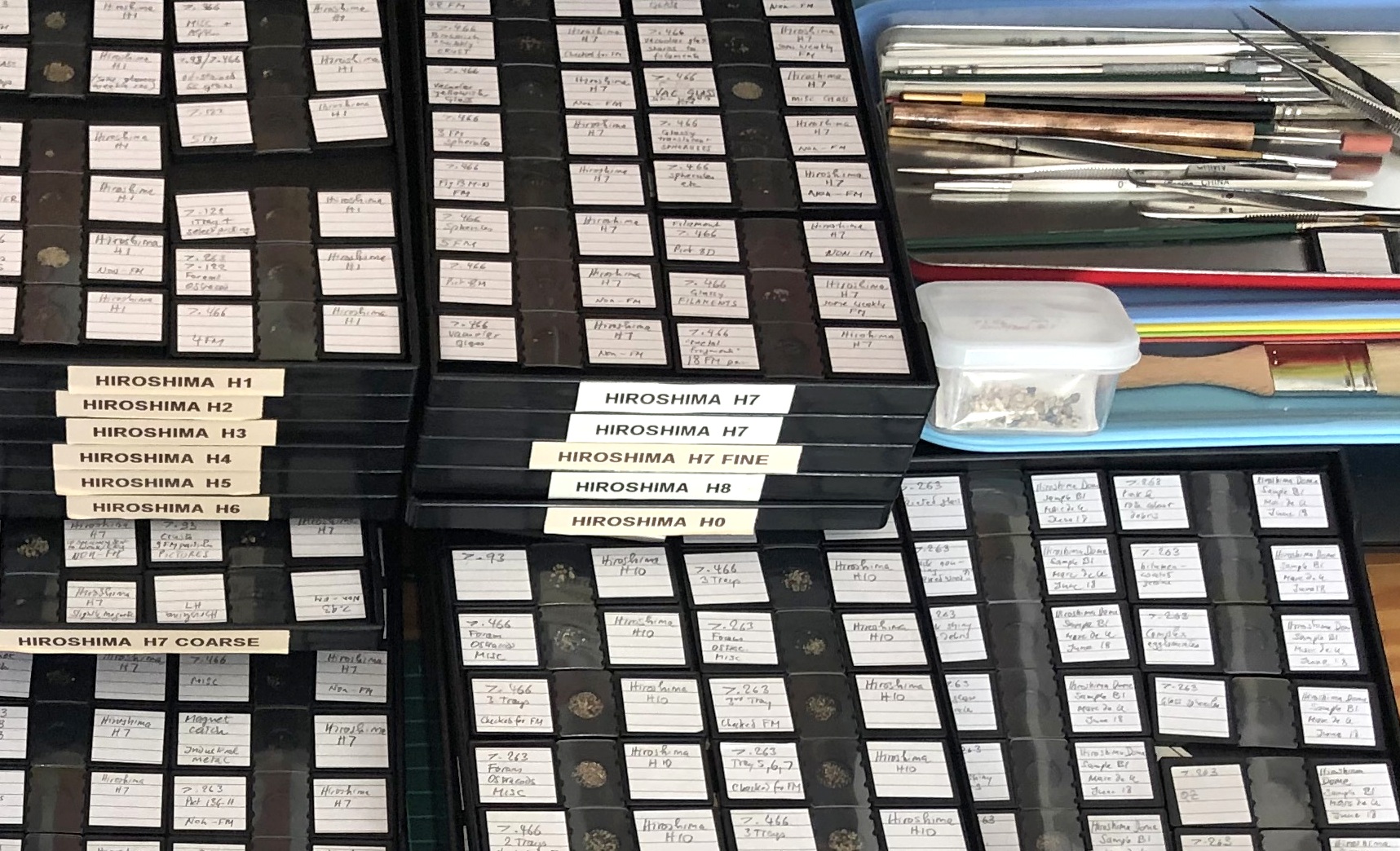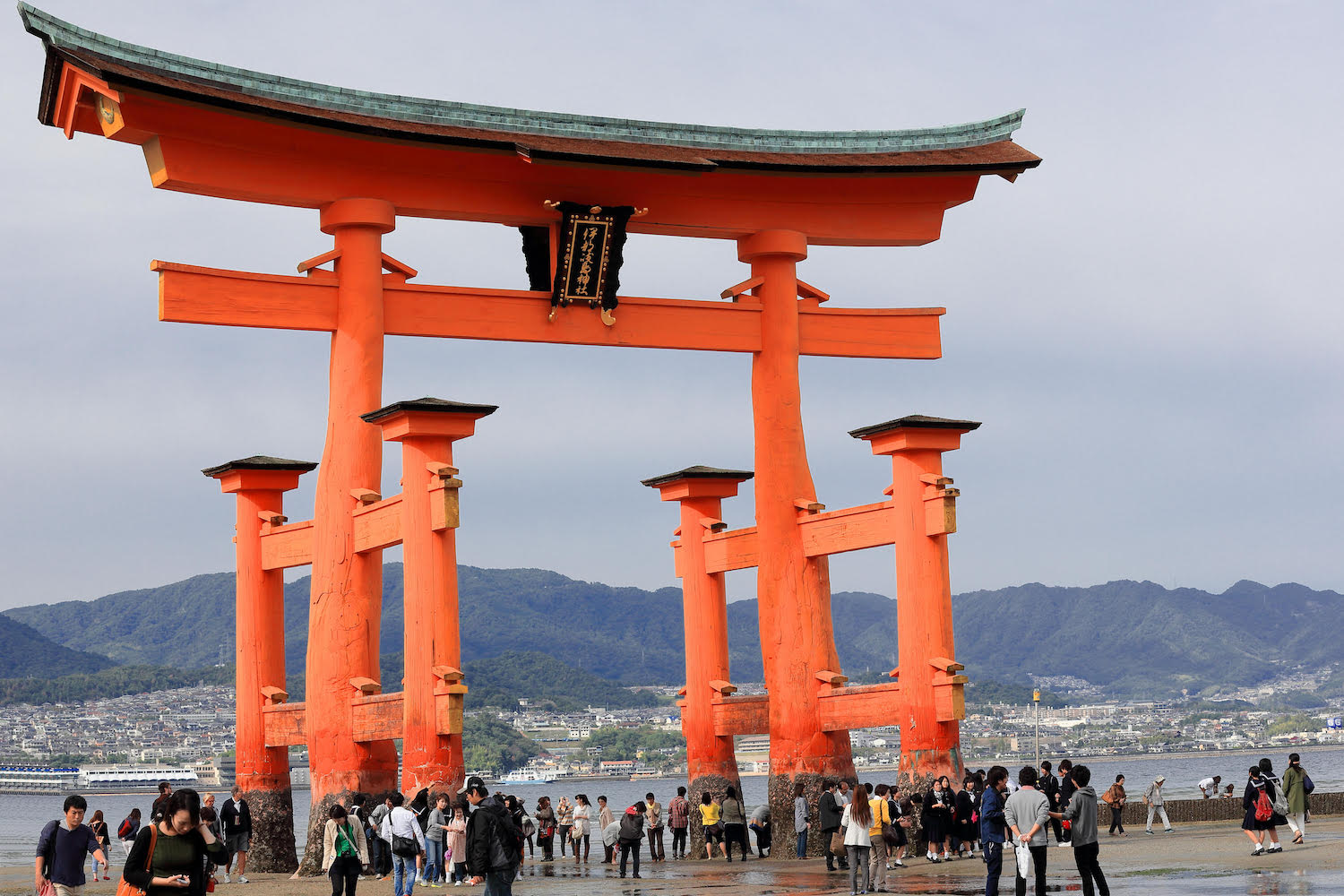
Visitors walk to the Great Torii Gate, which is associated with the Itsukushima Shinto Shrine on Japan’s Miyajima Island, near the city of Hiroshima. During high tide the gate is surrounded by water. Beach sands from the island were part of a study that had participation from researchers at Berkeley Lab and UC Berkeley. (Credit: iStock/rweisswald)
Mario Wannier, a career geologist with expertise in studying tiny marine life, was methodically sorting through particles in samples of beach sand from Japan’s Motoujina Peninsula when he spotted something unexpected: a number of tiny, glassy spheres and other unusual objects.
Wannier, who is now retired, had been comparing biological debris in beach sands from different areas in an effort to gauge the health of local and regional marine ecosystems. The work involved examining each sand particle in a sample under a microscope, and with a fine brush, separating particles of interest from grains of sediment into a tray for further study.
A surprise in the sand grains: glassy particles
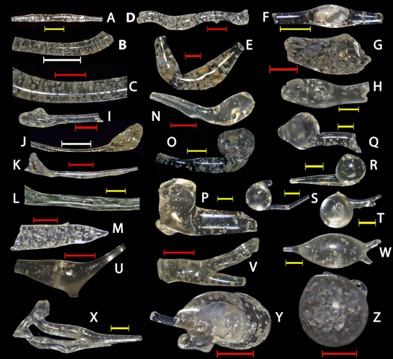
Click to view larger image. This assortment of glassy particles was discovered in beach sands near Hiroshima. (Credit: Anthropocene, Volume 25, March 2019, DOI: 10.1016/j.ancene.2019.100196)
“I had seen hundreds of beach samples from Southeast Asia, and I can immediately distinguish mineral grains from the particles created by animals or plants, so that’s very easy,” he said. In the Motoujina sands, collected by Wannier’s colleague, Marc de Urreiztieta, he found familiar traces of single-celled organisms known as foraminifera, which come in a variety of forms. They typically have shells and reside in and around seafloor sediment.
“But there was something else … it’s so obvious when you look at the samples,” he said. “You couldn’t miss these extraneous particles. They are generally aerodynamic, glassy, rounded – these particles immediately reminded me of some spherule (rounded) particles I had seen in sediment samples from the Cretaceous-Tertiary boundary,” the so-called K-T boundary now referred to as the Cretaceous-Paleogene (K-Pg) boundary that marked a planetary mass extinction event, including the dinosaurs’ die-off, about 66 million years ago.
In 1980, Luis Alvarez, a Nobel Laureate who worked at Lawrence Berkeley National Laboratory (Berkeley Lab) and UC Berkeley, together with his son, geologist Walter Alvarez, proposed a theory, based on a high concentration of iridium in deposits at the K-Pg boundary, that a large meteorite impact caused this massive die-off. Coupled with more recent evidence, scientists now believe that the impact occurred in the region of the Yucatan Peninsula. In meteorite impacts, liquified ground material is ejected into the atmosphere, forming droplets of glassy material that fall back to the ground.
Some of the glassy spheres that Wannier examined appeared to be fused together with other spheres, and others exhibited taillike features. While some of the glassy particles resembled those associated with meteorite impacts, others that Wannier found were not so familiar — among them were particles with a rubber-like composition and particles featuring a variety of materials coated in a layer or multiple layers of glass or silica. Many of the particles measured about 0.5 millimeter to 1 millimeter across.
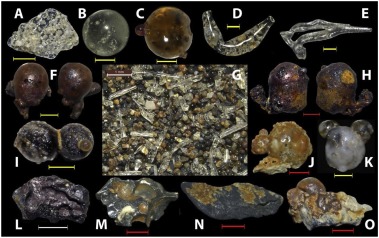
Click to view larger image. Examples of the broad range of particles that were collected from beach sands in Japan’s Motoujima Peninsula. (Credit: Anthropocene, Volume 25, March 2019, DOI: 10.1016/j.ancene.2019.100196)
Wannier had no idea at the time that this glassy menagerie of particles he encountered would lead to a years-long research effort that would involve scientists and experiments at Berkeley Lab and UC Berkeley. The effort would ultimately reveal the diversity and uniqueness of the studied particles, including unusual chemical and mineral mixes; the exotic high-temperature and high-pressure environment in which they formed; and the potential for new discoveries in further explorations.
Concentration, volume of material points to A-bomb blast
After this initial finding in 2015, Wannier traveled to Japan to collect more beach sand samples from the same region, near the city of Hiroshima.
In all of these samples, there were between 12.6 to 23.3 grams of these spheroids and other unusual particles for every kilogram (2.2 pounds) of sand. This odd assortment of glassy particles accounted for between 0.6 percent to 2.5 percent of all of the grains that were examined. Wannier plucked about 10,000 of these particles from the sands and sorted them into six different groups according to their physical traits.
The consistently high concentrations of this strange assortment of particles in beach sands collected about 4 to 7 miles from the city of Hiroshima raised his suspicions that they may be related to the atomic bomb blast that devastated Hiroshima on the morning of Aug. 6, 1945. That bomb had instantly killed 70,000 or more people, with a final death toll accounting for the associated radiation effects possibly exceeding 145,000. The bomb and resulting firestorms mostly leveled an area measuring more than 4 square miles, and destroyed or damaged an estimated 90% of structures in the city.
Based on the volume of the glassy debris found in the beach sands, Wannier and his colleagues estimated that a square kilometer, or roughly 0.4 square mile of beach sand in the area, collected from its surface to a depth of about 4 inches, would contain about 2,200 to 3,100 tons of the particles.
A study detailing the analyses of the material, published in the journal Anthropocene, provides an exhaustive exploration of the many possible sources for the unusual particles, and concludes that they are A-bomb fallout from the destroyed city of Hiroshima.
“This was the worst manmade event ever, by far,” Wannier said. “In the surprise of finding these particles, the big question for me was: You have a city, and a minute later you have no city. There was the question of: ‘Where is the city – where is the material?’ It is a trove to have discovered these particles. It is an incredible story.”
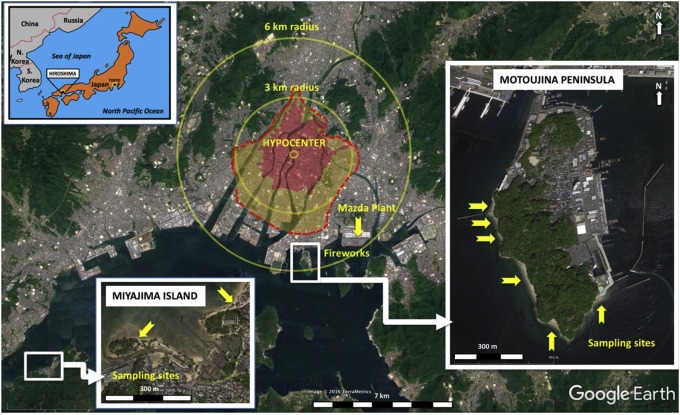
This image shows sites where beach sands were collected, and the area that was devastated by the Hiroshima A-bomb blast. (Credit: Google Earth; Anthropocene, Volume 25, March 2019, DOI: 10.1016/j.ancene.2019.100196)
Connecting with Berkeley Lab, UC Berkeley for detailed analyses
Wannier and de Urreiztieta wanted to learn more about the samples, so they contacted Rudy Wenk, a professor of mineralogy at UC Berkeley and a longtime Berkeley Lab affiliate – Wannier and Wenk had both studied geology at the University of Basel, Switzerland, decades earlier.
Wenk first studied the Hiroshima-area samples using an electron microscope. This enabled a detailed exploration of their composition and structures.
He observed a wide variety in the chemical composition of the samples, including concentrations of aluminum, silicon and calcium; microscopic globules of chromium rich iron; and microscopic branching of crystalline structures. Others were composed mostly of carbon and oxygen.
“Some of these look similar to what we have from meteorite impacts, but the composition is quite different,” Wenk said. “There were quite unusual shapes. There was some pure iron and steel. Some of these had the composition of building materials.”
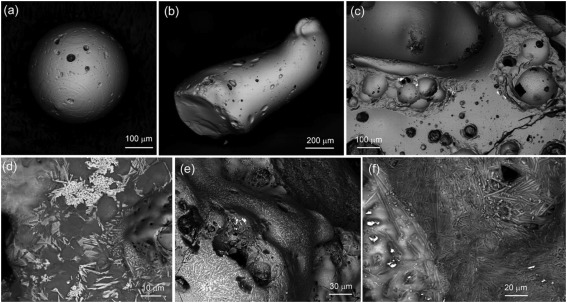
Click to view larger image. Scanning electron microscopy images of melt debris particles. (Credit: UC Berkeley)
To gather further details about the samples, Wenk turned to Berkeley Lab, where he and his students have conducted many electron microscopy and X-ray experiments over the years. He took selected samples to Berkeley Lab’s Advanced Light Source (ALS) and conducted a number of measurements there.
Nobumichi “Nobu” Tamura, a staff scientist at the ALS who Wenk had worked with before, along with then-ALS colleagues Camelia Stan and Binbin Yue (Stan and Yue have since left Berkeley Lab), assisted in analyzing the samples at a scale of less than 1 micron, or 1 millionth of a meter, using a technique known as X-ray microdiffraction.
Both of Tamura’s parents were born in Japan, and he said that he was personally interested in participating in the study because of his family ancestry. “My dad was 12 years old when the bombing happened, and lived just 200 miles north of Hiroshima, so he witnessed directly the news and outcomes of these terrible events,” Tamura said.
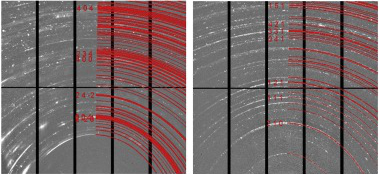
These images, produced by a technique called X-ray microdiffraction at Berkeley Lab’s Advanced Light Source, shows concentrations of the minerals anorthite (left) and mullite (right) in particles recovered from beach sands in Japan’s Motoujina Peninsula. (Credit: Berkeley Lab)
The experiments and related analyses determined that the particles had formed in extreme conditions, with temperatures exceeding 3,300 degrees Fahrenheit (1,800 Celsius), as evidenced by the assemblage of anorthite and mullite crystals that the researchers identified.
Tamura noted that the unique microstructure of the studied particles and the sheer volume of melt debris present also provide strong evidence for how they were formed.
“The atomic explosion hypothesis is the only logical explanation for their origin,” he said.
Study details researchers’ findings
Many of the sphere-shaped particles and other bits likely formed at a high elevation around the rising fireball of the blast. The materials swept up from the ground bubbled and mixed in this turbulent environment before cooling and condensing and then raining down.
Wannier explained the processes that likely formed the materials in an atomic cloud: “The ground material is volatized and moved into the cloud, where the high temperature changes the physical condition,” Wannier said. “There are a lot of interactions between particles. There are lots of little spheres that collide, and you get this agglomeration.”
Researchers also found that the composition of the debris particles corresponds closely with materials that were common in Hiroshima at the time of the bombing, such as concrete, marble, stainless steel, and rubber.
Other studies have analyzed melt debris from the Trinity test site in New Mexico – where the first nuclear explosion was triggered – and from underground nuclear test sites in Nevada. But those samples have a distinctly different composition that is associated with their local geological environment.
The Trinity debris is dubbed trinitite, and researchers in the latest study have dubbed the melt particles they studied as Hiroshimaite to highlight their distinct characteristics and their likely origin in the Hiroshima A-bomb explosion.
“Hiroshimaite particles are much more complex and diverse than trinitite,” Tamura said, owing to their likely genesis in Hiroshima’s urban center.
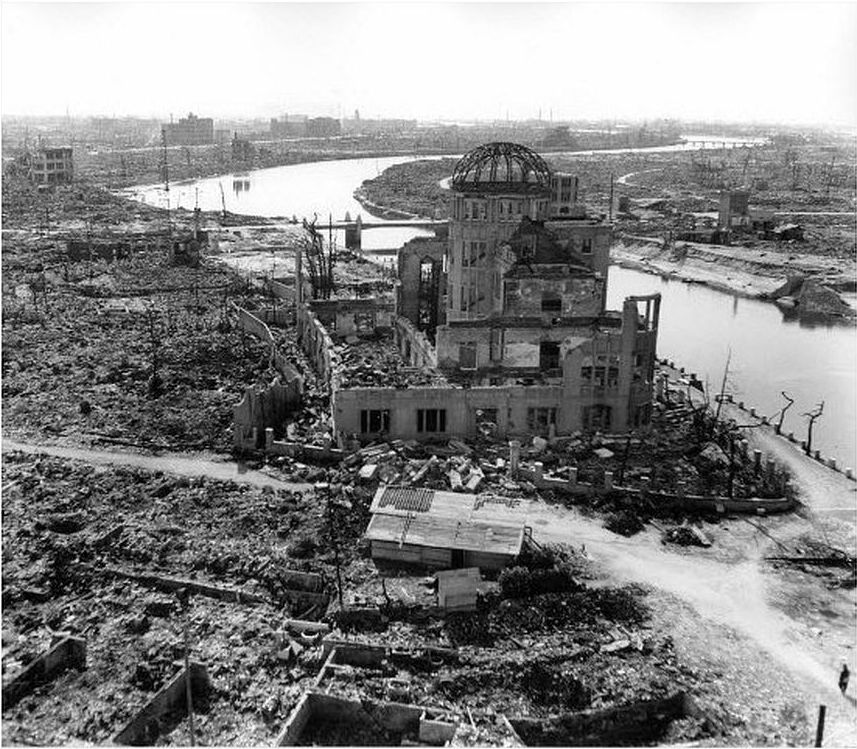
This 1945 photo shows the destruction of the A-bomb blast in Hiroshima, including damage to the building that is now known as the Hiroshima Peace Memorial. The structure is also called the Genbaku Dome or Atomic Bomb Dome.
While there had been concerted international efforts to aid survivors suffering from radiation effects, to measure the radiation levels, and to assess the overall damage caused by the 1945 atomic bombings in Hiroshima and Nagasaki, the study noted that the melt debris associated with these bombings had apparently not been previously studied.
The latest study encourages additional tests to find out if any samples carry radioactive elements, and to conduct further studies in the Hiroshima and Nagasaki areas.
Plans for follow-up studies
Wannier said he has received soil samples from ground zero at Hiroshima and may look for debris samples from deeper underground there, and he has also received a soil sample containing glassy debris from a streambed about 19 miles northwest of where the Hiroshima A-bomb struck – historic records show that area was in the path of the atomic cloud.
He said he also hopes to explore whether the melt debris exhibits similarities to materials associated with volcanic eruptions.
Tamura and Wenk noted that this initial study focused on just a small number of melt debris particles, and it may be worthwhile to pursue a larger study to learn more about the extreme conditions that produced the debris and to possibly reveal more unique chemistry or mineralogy.
Wenk added, “It was quite fascinating to look at all of these materials. What we hope is to get other people interested in looking at this in more detail, and in looking for examples around the Nagasaki A-bomb site.”
Wenk sent a copy of the latest study to Jun-Ichi Ando, a professor in the Department of Earth and Planetary Systems Science in the Graduate School of Science at Hiroshima University – they had met while Wenk was serving as a visiting professor at Hiroshima University in 1998.
“I think this kind of research is very important for Hiroshima University, as a university located at the A-bomb site,” Ando said, noting that he shared the study with a colleague who is a mineralogist and studies the Yucatan-region’s meteorite impact. He also shared it with Rebun Kayo, a research fellow at the university who leads an outreach group that raises awareness about nuclear weapons by sharing bomb-scarred Hiroshima roof tiles and bricks with institutions around the world.
A view of the domed structure now known as the Hiroshima Peace Memorial that was near ground zero of the 1945 A-bomb blast and still stands today. (Credit: Max Pixel)
In an unrelated effort, Ando has studied a large chunk of granite associated with the Atomic Bomb Dome structure in Hiroshima – it was the only building that remained standing near ground zero. Kayo found and recovered the piece of granite from a local riverbed near the domed building in 2017. It is also known as the Genbaku Dome or Hiroshima Peace Memorial.
“I tried to find evidence of melting and the shock wave recorded on the surface of the granite pillar” using electron microscopy, Ando said – his own research typically focuses on microstructures of rocks in seismic faults.
Wannier said the debris study has been an enlightening journey for him, and he hopes to continue with the research. “For 70-plus years this material has been there and was never studied in detail. We hope this raises attention among the scientific community,” he said.
“We hope people take advantage of this opportunity.”
The Advanced Light Source is a DOE Office of Science User Facility.
###
Founded in 1931 on the belief that the biggest scientific challenges are best addressed by teams, Lawrence Berkeley National Laboratory and its scientists have been recognized with 13 Nobel Prizes. Today, Berkeley Lab researchers develop sustainable energy and environmental solutions, create useful new materials, advance the frontiers of computing, and probe the mysteries of life, matter, and the universe. Scientists from around the world rely on the Lab’s facilities for their own discovery science. Berkeley Lab is a multiprogram national laboratory, managed by the University of California for the U.S. Department of Energy’s Office of Science.
DOE’s Office of Science is the single largest supporter of basic research in the physical sciences in the United States, and is working to address some of the most pressing challenges of our time. For more information, please visit science.energy.gov.
